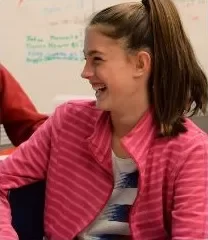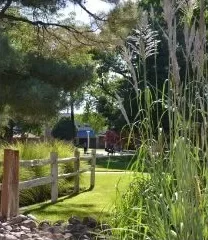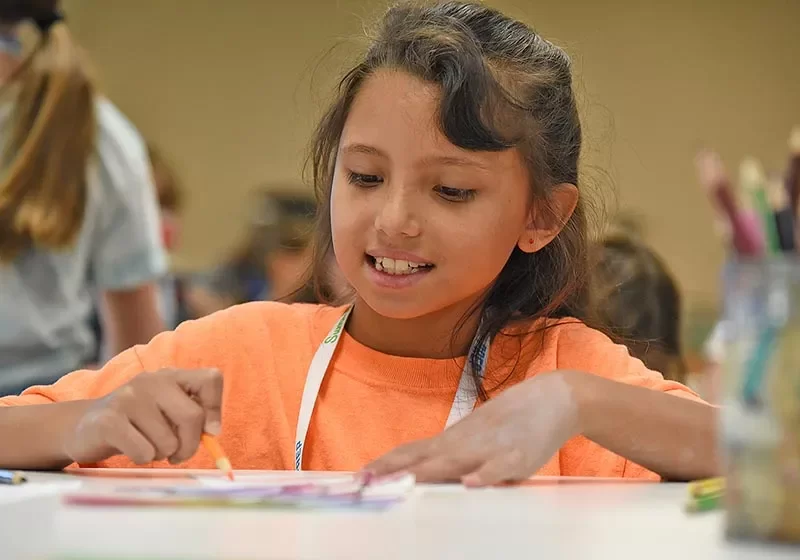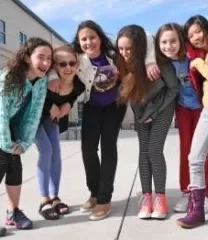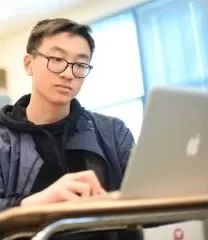DesignLab
Making Makers
Sandia Prep's DesignLab is a community-oriented makerspace where science, engineering, technical, and visual art enthusiasts meet regularly to share, explore, innovate, and collaborate using textiles, electronic hardware, manufacturing tools, and programming techniques.
The DesignLab is home to DareDevil Design, Entrepreneurial Studies and Innovation, Engineering, and two new courses, Architectural Studies and Product Design.

Together, these courses involve students in myriad challenges and competitions. The connections between engineering, art, and design become evident to students through such projects as:
- Designing cityscapes for the National Future City Competition
- Conceptualizing assistive technology solutions to increase the economic mobility and earning potential of people with disabilities
- Visualizing efficient and environmentally-friendly furniture based on biomimicry
- Two-week “hack-a-thons” that ask student teams to solve contemporary issues, such as challenges to virtual learning and what a post-COVID restaurant might look like
- Under the project called Global Goal 2: Zero Hunger, students design a vertical, affordable garden to allow low-resources families to grow their own food, thereby achieving food security and improved nutrition
What is a makerspace?
- A resource that creates the opportunity to put project theory into application, where failure is a welcomed component, and there is no penalty for failing
- A place for engaging learners in creative, higher-order problem solving through hands-on design, construction, and iteration; one that facilitates experimental play that engages students
- A community workspace for budding artists, craftspeople, engineers, makers, hobbyists, and hardware developers
- A movement to empower students as creators and tinkerers

What is in the DesignLab?
The DesignLab includes:
- 3D printers
- Laser-cutter equipment
- AutoCAD software
- Woodworking tools
- CNC router
- Mobile workstations
- CircuitMaker
- BIBO dual-extruder/laser engraver 3D printer
- Makyu Form Box
- …and much more!
What are the goals of the DesignLab?
- To provide innovative tools, so that students can develop ideas and try implementing them
- To act as an incubator; a space where students can go to learn the skills to create things and have access to the tools necessary to create them
- To balance social interaction with individual exploration, while keeping students close enough together to inspire each other with ideas
- To partner with other programs and groups on campus, such as science, art, and broadcasting
DesignLab-Focused Courses
A workshop environment where students (in a sixth-grade course and a seventh-grade course) engage in creative, critical, and constructive processes to develop products, ideas, and projects to help communities. Daredevil Design students participate in nationwide challenges such as the Future City Competition, in nonprofits such as the Lantern Project, and in additional endeavors with local organizations. Students conduct a “Presentation of Learning” to demonstrate their skills, understanding, and growth.
This senior capstone course helps develop an entrepreneurial mindset and teaches problem-solving skills that are essential to a student’s success later in life. The course provides students an opportunity to work with Albuquerque entrepreneurs, who present real-world business problems outlined in a scope of work, complete with hard deliverables and deadlines. Having done research, conducted customer interviews, and worked as a team to devise a solution, the students pitch their solutions directly to the business CEOs. In their fourth and final project, students work together to devise a concept for a business and pitch it “Shark Tank”-style to real investors.
This class is based around the three main principles of architecture—form, function, and material. Students explore a brief history of architecture and how it impacts our lives on a daily basis, and how we can use architecture to improve our lives with minimal environmental impact. Students will design, sketch, render, and fabricate an architectural structure that is functional, aesthetically sound, and considers ideal materials to support its design.
In this class, students investigate the functionality and aesthetics of common objects and challenge themselves to improve them using design thinking and craftsmanship. Students explore the function, form, and materiality of certain objects and products, and learn through brainstorming, sketching, and creating prototypes. They also practice innovating real-life solutions and using the design process to demonstrate problem-solving and artistic solutions.
The DesignLab Evolution
In 2014, a handful of Sandia Prep faculty got together to discuss how to steer our successful educational institution in a direction that upheld the high standards and rigors of a well-rounded, academic curricula, but regain and embrace at its core what students are all about: being curious, youthful, and playful.
At the time, the faculty members observed that standardized testing, quizzing, and lectures had conditioned students to focus on exacting, short-term memory answers. Students had been taught to suppress their curiosity and creativity and replace them with the anxiety of failure. Our small cohort of educators was exasperated since this was neither teaching nor learning, and called for the creation of an environment where students could unlearn how to be “good at school” and become better at experimenting and failing.
Sandia Prep’s Autonomous Creative Environment (SPACE) opened its doors at the start of the 2015 school year as a place for students to explore and tinker; it was the first of its kind in a local school. From carpentry to electronics and circuitry, to 3D printing and hackspaces, SPACE invited students to visit during their free periods and enjoy the opportunity to create and collaborate, but most importantly, to fail. Since it was not a formal class, students felt much more comfortable trying new things and working with previously unknown materials and tools. For two years, SPACE served as the school’s makerspace as well as the center for teachers to bring their students to work on larger, more intensive building projects.
At the end of that school year, the evidence was clear: Under the intrinsic motivation of creating for fun without the fear of failing, students were much more productive and likely to explore topics and themes outside of their comfort zones.
For the next couple of years, faculty took the SPACE model and worked on developing a more structured program. From these endeavors, the school introduced robotics and later a complete grade 8-12 engineering program. Using the engineering design process, students explored the principles of engineering and incorporating the experience of failure into their learning.
In 2017, Prep launched DareDevil Design as a design-thinking program for grades 6 and 7. The two-year repeatable program asked a simple yet powerful question: “How can we make the world a better place by making for others?” Prep added the step of empathy to the design process! By implementing this step, students conducted research via interviews to understand the needs of others. On the other end, in grade 12, Entrepreneurial Studies and Innovation (ESI) gave seniors a more elaborate method: Through interaction with local startup companies, students helped companies with their most pressing problems. Both DareDevil Design and ESI’s curricula hinged on the idea of purpose-based learning—having students participate in solving real-world problems by working alongside real-world experts.
SPACE’s influence continued to evolve, and by 2019 the program was ready to encompass an ever-growing number of disciplines and educators who craved collaboration on projects and challenges. Sandia Prep’s DesignLab was the result of many conversations centered on the already-existing objectives of making the world a better place and focusing on purpose-based learning. And now, this broad makerspace had expanded its vision to also adopt the Global Goals for Sustainable Development.
These goals, created in 2015, have the power to create a better world by 2030 by ending poverty, fighting inequality, and addressing climate change. Integrating social, economic, and environmental advancement, these goals represent the most ambitious agreement for sustainable development that world leaders have ever made.



